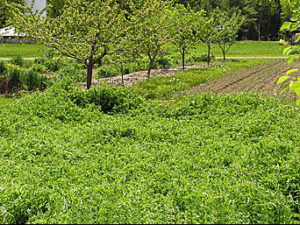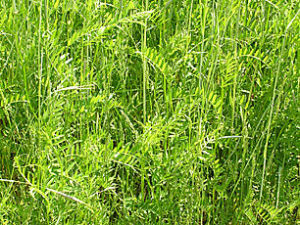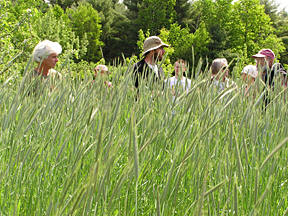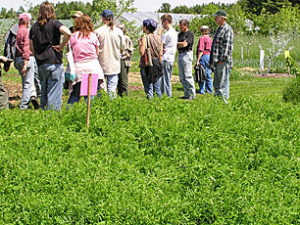 |
| Planting about a quarter of your garden to cover crops each year can add fertility, reduce erosion, help break pest cycles, and much more. English photo. |
by Eric Sideman, Ph.D.
The Heart of Organic Growing
Those who buy organic food often describe organic farming and gardening in the negative: as growing crops without using synthetic pesticides or fertilizers. From its very beginning, however, organic growing has been far more: It’s a system that is based on taking care of the soil. Building soil structure, biological activity and reservoirs of plant nutrients is the heart of successful organic growing. Organic production without synthetic pesticides or fertilizers can be easy: Just substitute natural materials; but that is not really what organic is about. Organic farming and gardening are all about soil husbandry. The most valuable product of the organic approach is not the crop but the good soil you build.
The best practice for feeding soil microbes, building soil structure and managing plant nutrients is growing green manures – crops that are planted with no intention of harvesting them but with a plan to till them into the soil while they are still green plants. At that time they serve as a food source for all of the life in the soil, such as the fungi, insects, bacteria, etc. Feeding the soil critters keeps them numerous and active. By far the most negative impact of farming with only bags of synthetic fertilizers and pesticides is the loss of these critters. They starve to death without added organic matter, and eventually the soil becomes what some call “dead,” which is a pretty accurate description.
 |
| The upright stems of winter rye support the upward growth of hairy vetch. English photo. |
Organic producers depend on a living soil for conserving and recycling nutrients, but the action of microbes may be even more beneficial as they decompose organic matter, releasing organic compounds that “glue” soil particles into crumb-like structures. This soil structure is crucial for healthy roots: It creates spaces for water and air, which roots need. Compost is a great soil amendment that will help hold nutrients and water in the soil, but it will not feed microbes as well as a green manure, simply because it has already been eaten in the compost pile.
Green manures are not just for farmers. Their use does fit well into farms with many fields, because whole fields can be pulled out of crop production and put into green manures for a season or two, but gardeners can do this too. Obviously a gardener could have more than one garden, and the gardens could be used as different “fields” – just on a smaller scale than farming. More commonly, gardeners make a single garden a bit larger than needed and pull a different section out of crop production each year to plant a green manure.
 |
| Eric Sideman (left) and Clayton Carter (center) explained the benefits of growing a winter rye and hairy vetch cover crop to attendees at MOFGA’s Small Farm Field Day in early June. English photo. |
Other Benefits
A question I frequently get at the MOFGA office is, “What is the best green manure?” There is no “best.” When choosing which crop to plant as a green manure, a gardener must decide which benefits of green manure are most important at that time. In addition to adding fresh organic matter to soil to feed the microbes, green manures can be rotated with crops to manage weeds, pull up nutrients that are deep in the soil, add nitrogen to the soil and break crop pest cycles. In different years or in different gardens, one benefit may be more important than others, and that benefit will help determine which green manures to plant. An overriding concern is equipment: Some green manures need to be mowed and tilled into the soil with heavy equipment. If you don’t own this equipment, you may be able to borrow it or hire the work out; or you can choose a green manure that is easy to handle with the equipment you do own.
For details on which species to plant and seeding rates, see MOFGA’s “Fact Sheet on Green Manures” (Fact Sheet # 10, at www.mofga.org under “publications”). For more detail, I suggest The Northeast Cover Crop Handbook by Marianne Sarrantonio. Meanwhile, here are some basics for choosing the crop for your purpose:
 |
| In early August 2006, just before winter squash started vining across the path in this plot at MOFGA’s Common Ground Education Center, MOFGA’s farmers-in-residence undersowed hairy vetch and then hoed the plot for the last time that year, lightly covering the vetch seeds in the process. The dense canopy of squash prevented the vetch from overtaking the crop. After the squash vines died, the vetch grew abundantly before (and after) winter. The following spring it was mowed and incorporated into the soil. English photo. |
Green Manures for Fall Cover
Fall cover crops are planted to catch leftover nutrients and prevent them from being lost in fall and spring rains and melting snow. As the green manure decomposes in the spring, those nutrients are released to the next crop. Winter rye is the best green manure for this purpose. It catches more nutrients than any other, holds them better, and can be planted later in the fall than any other. The problem for gardeners is that winter rye lives through the winter and does most of its growth in May, when gardeners want to plant – and when it is hard to kill the cover crop and till it into the soil. Oats, in contrast, grow well in the fall and are killed by winter, so in spring the mat of dead oats is easy to till in. Even farmers turn to oats for fields that they want to plant early.
Green Manures to Manage Weeds
The first task in choosing a green manure to manage weeds is to identify the existing weed species and learn about its ecology. Some weeds appear in the spring, summer or fall; some are there all the time.
With annual weeds, your goal is to get rid of all existing seeds in the soil and not let any new seeds be deposited. With perennial weeds, your goal is to starve their roots and rhizomes by not letting the tops grow.
The best way to use green manures to manage weeds is to combine the smothering effects of green manure species such as buckwheat with periods of time when the soil is left bare and is tilled weekly. One tilling stimulates weed seeds to germinate, and then the next tilling kills the young weed seedlings before they go to seed. The problem with simply planting a green manure and leaving it for long periods is that many weeds will grow in the shade of the green manure. They may grow very slowly, but they probably will drop seeds eventually and, rather than depleting the soil seed bank, will be depositing more seeds into it. Combining periods of fallow to kill weed seeds with periods of green manure growth is a compromise: Tilling reduces soil structure and organic matter, but then the green manure builds these up.
Perennial weeds are even harder to kill with green manures alone, as many species tend to lumber along in the shade just waiting for the green manure to be killed, after which the weeds grow prolifically. Generally, even longer fallow periods, where the perennial weeds are kept from producing top growth, are needed to deplete roots of stored food, and then a green manure can be planted.
Green Manures to Add Nitrogen to Soil
Organic gardeners often have a problem getting enough nitrogen into the soil for optimum crop yields. For example, adding enough compost to a garden to supply sufficient nitrogen will risk oversupplying phosphorus, which can be an environmental problem. The best way to get nitrogen into the soil without raising this risk at all is to rotate legumes in different sections of the garden. Most sustainable farmers have about 25 to 50% of their land in legume cover crops.
Legumes can develop a symbiotic relation with a species of bacteria that can take nitrogen gas from the atmosphere and fix that nitrogen into biological compounds. No organisms other than a handful of species of bacteria are able to do this, so it is very interesting that all life depends on these bacteria. When these bacteria break down, nitrogen in their bodies is released into the soil in a form that plants can pick it up. By the way, the only way animals can get nitrogen for their proteins is to eat proteins.
I suggest making gardens 25% larger than needed for the desired crops and using that extra land to get your weeds under control, to bring nitrogen into your system and/or to feed the microbes that keep your soil alive.
About the author: Eric Sideman is MOFGA’s organic crops specialist. You can contact him with your questions at 568-4142 or [email protected].
